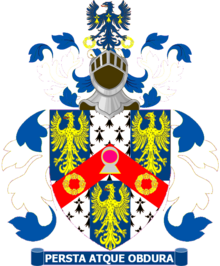| William BeecheyRA | |
|---|---|
 Sir William Beechey, self-portrait, c. 1800 Sir William Beechey, self-portrait, c. 1800 | |
| Born | (1753-12-12)12 December 1753 Burford, Oxfordshire, England, Kingdom of Great Britain |
| Died | 28 January 1839(1839-01-28) (aged 85) London, England, United Kingdom |
| Nationality | British |
| Known for | Painting |
| Spouses |
|
William Beechey RA (12 December 1753 – 28 January 1839) was a British portraitist during the golden age of British painting.
Early life
Beechey was born at Burford, Oxfordshire, on 12 December 1753, the son of William Beechey, a solicitor, and his wife Hannah Read. Both parents died when he was still quite young in the early 1760s, and he and his siblings were brought up by his uncle Samuel, a solicitor who lived in nearby Chipping Norton.
The uncle was determined that the young Beechey should likewise follow a career in the law, and at an appropriate age he was entered as a clerk with a conveyancer near Stow-on-the-Wold. But as The Monthly Mirror later recorded in July 1798, he was: "Early foredoomed his soul to cross/ And paint a picture where he should engross".
Career
| This section needs additional citations for verification. Please help improve this article by adding citations to reliable sources in this section. Unsourced material may be challenged and removed. Find sources: "William Beechey" – news · newspapers · books · scholar · JSTOR (December 2022) (Learn how and when to remove this message) |

Beechey was admitted to the Royal Academy Schools in 1772, where he is thought to have studied under Johan Zoffany. He first exhibited at the Academy in 1776. His earliest surviving portraits are small-scale full-length and conversation pieces which are reminiscent of Zoffany. In 1782, he moved to Norwich, where he gained several commissions, including a portrait of John Wodehouse and a series of civic portraits for St. Andrew's Hall, Norwich. By 1787, he had returned to London, and in 1789, he exhibited a celebrated portrait of John Douglas, Bishop of Carlisle (now in Lambeth Palace). Beechey's career during this period is marked by a succession of adept and restrained portraits in the tradition of Joshua Reynolds.

Beechey's style perfectly suited the conventional taste of the royal family, and in 1793, he was commissioned to paint a full-length portrait of Queen Charlotte and subsequently named as her official portrait painter. That same year, he was elected as an associate member of the Royal Academy.
Following his royal appointment, the number of royal commissions he undertook increased markedly, and in 1797 he exhibited six royal portraits. In 1798, he was elected a full member of the Royal Academy and painted George III and the Prince of Wales Reviewing Troops for that year's academy's exhibition. This enormous composition depicts King George III, the Prince of Wales and staff officers on horseback at an imagined cavalry review in Hyde Park. The king was reported to be delighted with the painting and rewarded Beechey with a knighthood.
Joseph Farington's Diaries give many accounts of Beechey's relations with the royal family during this period, including his temporary fall from favour in 1804, which Farington attributes to the vagaries of George III's mental condition.
Beechey's portraits of the turn of the century are considered to be his most colourful and lively. They are closer to the flamboyant and free techniques employed by his younger rivals, John Hoppner and Sir Thomas Lawrence.
Royal patronage resumed in around 1813, when Beechey was appointed portrait painter to Prince William Frederick, Duke of Gloucester, and culminated with his appointment in 1830 as principal portrait painter to William IV. In 1830, he stood for election as President of the Royal Academy following the death of Thomas Lawrence, finishing second to Martin Archer Shee. In 1836, Beechey retired to Hampstead and on 9–11 June that year, the contents of his studio along with his collection were sold at Christie's.
Although capable of impetuousness and irascibility, Beechey was known for his generosity to students. In particular, he took a close interest in the career of the young John Constable.
Subjects
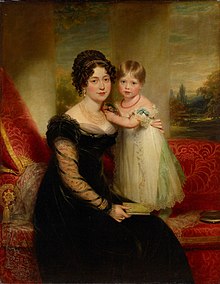
During a prolific career spanning half a century, Beechey painted many of the leading figures of his day. His sitters included:
In his 1978 novel Desolation Island, Patrick O'Brian wrote that Capt. Jack Aubrey had been painted by Beechey. The portrait, which showed Aubrey in Royal Navy uniform wearing the insignia of the Order of the Bath, hung in his home, Ashgrove Cottage.
Family
William Beechey's first marriage was to Mary Ann Jones (c. 1760–1793) in 1772 (other sources say 1778). Their children included British painter and Egyptologist Henry William Beechey (1788–1862).
Following his first wife's death, Beechey married the successful miniature painter Anne Phyllis Jessop (1764–1833) in 1793. They had many children together, including: Royal Navy captain, geographer, and politician Frederick William Beechey (1796–1856); painter George Duncan Beechey (1798–1852); clergyman St. Vincent Beechey (1806–1899); and painter and admiral in the British navy Richard Brydges Beechey (1808–1895).
-
 Miss Harriet Beechey,
Miss Harriet Beechey,
by William Beechey, c. 1800 -
 Anne Jessop, Lady Beechey, by William Beechey, c. 1800
Anne Jessop, Lady Beechey, by William Beechey, c. 1800
Prices at auction
Beechey's Portrait of James Watt sold for £153,440 at Sotheby's on 20 March 2003. His Portrait of Mirza Abu'l Hassan Khan, Envoy Extraordinary and Minister Plenipotentiary to the Court of King George III sold for £181,600 at Christie's on 8 June 2006. His Portrait of George Douglas, 16th Earl of Morton in the dress of the Royal Company of Archers sold for £481,250 at Christie's on 5 July 2011. His portrait of The Dashwood Children sold at auction for $821,000 including premium at Christie's on 29 January 2014.
Gallery
Beechey's works are represented in many of the world's leading collections, including the Louvre, the Smithsonian Institution, the Royal Collection, the Royal Academy of Arts, the National Portrait Gallery, London, the Tate and the Metropolitan Museum of Art.
-
 Edward Miles, 1785
Edward Miles, 1785
-
 Sir John Wodehouse, 1785
Sir John Wodehouse, 1785
-
 Dorothea Jordan as Rosalind, 1787
Dorothea Jordan as Rosalind, 1787
-
 Admiral Jervis, 1787
Admiral Jervis, 1787
-
 The Dashwood Children, c. 1789
The Dashwood Children, c. 1789
-
 Paul Sandby, c. 1789
Paul Sandby, c. 1789
-
 George Douglas, 16th Earl of Morton (1761–1827), c. 1790
George Douglas, 16th Earl of Morton (1761–1827), c. 1790
-
 John Carr, 1791
John Carr, 1791
-
 Sarah Siddons, 1793
Sarah Siddons, 1793
-
 Sir Francis Ford's Children Giving a Coin to a Beggar Boy, 1793
Sir Francis Ford's Children Giving a Coin to a Beggar Boy, 1793
-
 Thomas Law Hodges, 1795
Thomas Law Hodges, 1795
-
 Master James Hatch, 1796
Master James Hatch, 1796
-
 Queen Charlotte, 1796
Queen Charlotte, 1796
-
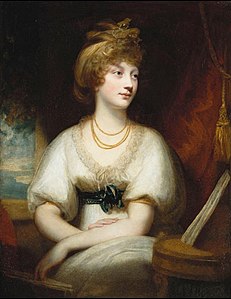 Princess Amelia, 1797
Princess Amelia, 1797
-
 Frederica, Duchess of York, 1797
Frederica, Duchess of York, 1797
-
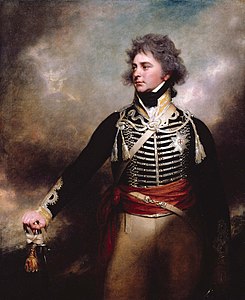 Portrait of George, Prince of Wales, c. 1798
Portrait of George, Prince of Wales, c. 1798
-
 George III and the Prince of Wales Reviewing Troops, 1798
George III and the Prince of Wales Reviewing Troops, 1798
-
 Thomas Hope, 1798
Thomas Hope, 1798
-
 Portrait of John Philip Kemble, 1799
Portrait of John Philip Kemble, 1799
-
 Sketch for portrait of Horatio, 1800
Sketch for portrait of Horatio, 1800
-
 Elizabeth Eden, Lady Godolphin (1780–1847), c. 1800
Elizabeth Eden, Lady Godolphin (1780–1847), c. 1800
-
 Portrait of Horatio Nelson, 1801
Portrait of Horatio Nelson, 1801
-
 James Watt (1736–1819), c. 1802
James Watt (1736–1819), c. 1802
-
 Princess Augusta Sophia, c. 1802
Princess Augusta Sophia, c. 1802
-
 George Rose, 1802
George Rose, 1802
-
 Portrait of Henry Addington, 1803
Portrait of Henry Addington, 1803
-
 Princess Sophia of Gloucester, c.1803
Princess Sophia of Gloucester, c.1803
-
 Lord Mulgrave, 1807
Lord Mulgrave, 1807
-
 Adolphus, Duke of Cambridge, 1808
Adolphus, Duke of Cambridge, 1808
-
 Henry Halford, 1809
Henry Halford, 1809
-
 John Duckworth, 1809
John Duckworth, 1809
-
 David Wilkie, c.1809
David Wilkie, c.1809
-
 Mirza Abu'l Hassan Khan, 1809–10
Mirza Abu'l Hassan Khan, 1809–10
-
 Portrait of Francis Bourgeois, 1810
Portrait of Francis Bourgeois, 1810
-
 Portrait of Harriet Mellon, 1815
Portrait of Harriet Mellon, 1815
-
 Portrait of Lord Beresford, c. 1815
Portrait of Lord Beresford, c. 1815
-
 Portrait of Thomas Picton, c. 1815
Portrait of Thomas Picton, c. 1815
-
 Portrait of Augusta, Duchess of Cambridge, 1818
Portrait of Augusta, Duchess of Cambridge, 1818
-
 Edward, Duke of Kent, 1818
Edward, Duke of Kent, 1818
-
 The Misses Plowden, 1819
The Misses Plowden, 1819
-
![]], 1820](https://upload.wikimedia.org/wikipedia/commons/thumb/1/1d/Vice-Admiral_Sir_George_Cockburn%2C_1772-1853_RMG_BHC2618.tiff/lossy-page1-199px-Vice-Admiral_Sir_George_Cockburn%2C_1772-1853_RMG_BHC2618.tiff.jpg) ]], 1820
]], 1820
-
 Joseph Nollekens, 1822
Joseph Nollekens, 1822
-
 Robert Grant, 1823
Robert Grant, 1823
-
 Joseph Stannard, 1824
Joseph Stannard, 1824
-
 Miss Windham, 1828
Miss Windham, 1828
-
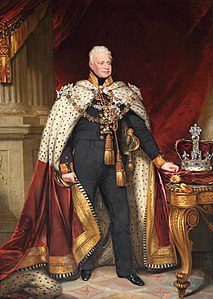 William IV, c.1830
William IV, c.1830
-
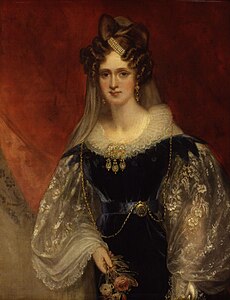 Queen Adelaide, c. 1831
Queen Adelaide, c. 1831
Coat of arms
Beechey was granted arms on 16 February 1829.
References
- , Le Louvre, Retrieved 25 September 2018
- Roberts 1907, p. 3.
- "Sir William Beechey RA (1753–1839)". HistoricalPortraits.com. Philip Mould. Retrieved 10 March 2019.
- ^ Chisholm 1911.
- Redgrave & Redgrave 1947, p. 131.
- Hermann p.30
- John Wilson, "Beechey, Sir William (1753–1839)", Oxford Dictionary of National Biography, Oxford University Press, 2004; online edn, Oct 2006 Retrieved 2 May 2017
- , Christie's, Retrieved 25 September 2018
- , Christie's, Retrieved 25 September 2018
- , Christie's, Retrieved 25 September 2018
- , Christie's, Retrieved 25 September 2018
- "Grant of Arms: Sir William Beechey 1829". Heraldry Online. 15 September 2018. Retrieved 25 August 2019.
Sources
- Hermann, Like. Nineteenth Century British Painting. Charles de la Mare, 2000.
- Redgrave, Richard; Redgrave, Samuel (1947) . A Century of Painters of the English School. Sampson Low, Marston.
- Roberts, W. (1907). Sir William Beechey, R.A. London: Duckworth & Co.
- Chisholm, Hugh, ed. (1911). "Beechey, Sir William" . Encyclopædia Britannica. Vol. 3 (11th ed.). Cambridge University Press. p. 640.
- Laughton, John Knox (1885). "Beechey, Frederick William" . In Stephen, Leslie (ed.). Dictionary of National Biography. Vol. 4. London: Smith, Elder & Co.
External links
- 178 artworks by or after William Beechey at the Art UK site
| William Beechey | |
|---|---|
| Paintings |
|
| Other | |
